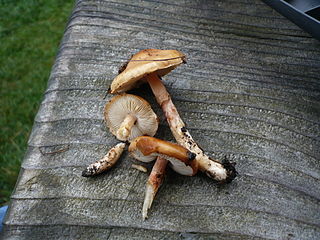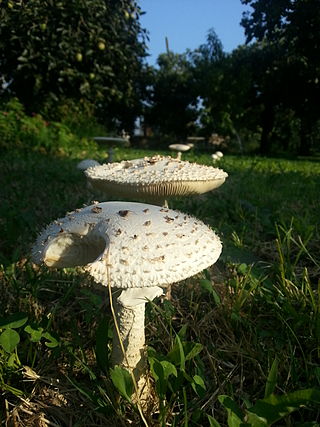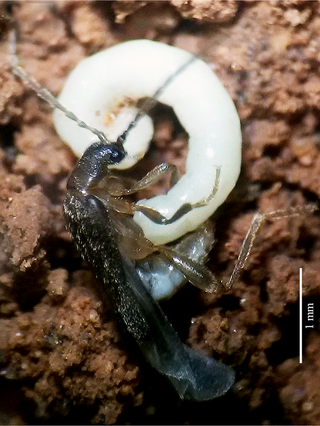
The Boletaceae are a family of mushroom-forming fungi, primarily characterised by small pores on the spore-bearing hymenial surface, instead of gills as are found in most agarics. Nearly as widely distributed as the agarics, the family is renowned for hosting some prime edible species highly sought after by mushroom hunters worldwide, such as the cep or king bolete . A number of rare or threatened species are also present in the family, that have become the focus of increasing conservation concerns. As a whole, the typical members of the family are commonly known as boletes.

Lactarius is a genus of mushroom-producing, ectomycorrhizal fungi, containing several edible species. The species of the genus, commonly known as milk-caps, are characterized by the milky fluid ("latex") they exude when cut or damaged. Like the closely related genus Russula, their flesh has a distinctive brittle consistency. It is a large genus with over 500 known species, mainly distributed in the Northern hemisphere. Recently, the genus Lactifluus has been separated from Lactarius based on molecular phylogenetic evidence.

Limacella is a genus of mushroom-forming fungi in the family Amanitaceae in order Agaricales. Some of the species have been classified as members of genus Lepiota. Limacella was described by mycologist Franklin Sumner Earle in 1909.

Sordariomycetes is a class of fungi in the subdivision Pezizomycotina (Ascomycota). It is the second-largest class of Ascomycota, with a worldwide distribution that mostly accommodates terrestrial based taxa, although several can also be found in aquatic habitats. Some are phytopathogens that can cause leaf, stem, and root diseases in a wide variety of hosts, while other genera can cause diseases in arthropods and mammals.

Boletus is a genus of mushroom-producing fungi, comprising over 100 species. The genus Boletus was originally broadly defined and described by Carl Linnaeus in 1753, essentially containing all fungi with hymenial pores instead of gills. Since then, other genera have been defined gradually, such as Tylopilus by Petter Adolf Karsten in 1881, and old names such as Leccinum have been resurrected or redefined. Some mushrooms listed in older books as members of the genus have now been placed in separate genera. These include such as Boletus scaber, now Leccinum scabrum, Tylopilus felleus, Chalciporus piperatus and Suillus luteus. Most boletes have been found to be ectomycorrhizal fungi, which means that they form a mutualistic relationship with the roots system of certain kinds of plants. More recently, Boletus has been found to be massively polyphyletic, with only a small percentage of the over 300 species that have been assigned to Boletus actually belonging there and necessitating the description and resurrection of many more genera.

Pleosporaceae is a family of sac fungi. They are pathogenic to humans or saprobic on woody and dead herbaceous stems or leaves.

The Fomitopsidaceae are a family of fungi in the order Polyporales. Most species are parasitic on woody plants, and tend to cause brown rots. The name comes from Fomitopsis + -aceae.

The Ostropales are an order of fungi in the class Lecanoromycetes. The order was circumscribed by Swedish botanist John Axel Nannfeldt in 1932. The order contains 4 families and 46 genera, including 6 genera of uncertain familial placement.
The Trichosphaeriales are an order of sac fungi. It is monotypic, and consists of the single family, the Trichosphaeriaceae. In 2017, the family of Trichosphaeriaceae was placed in Diaporthomycetidae families incertae sedis, which was accepted by Wijayawardene et al. (2018), and Wijayawardene et al. 2020. The order of Trichosphaeriales was also unplaced. They are generally saprobic and pathogenic on plants, commonly isolated from herbivore dung.

Gymnopus is a genus of fungus in the family Omphalotaceae. The genus has a widespread, cosmopolitan distribution and contains about 300 species.

Bjerkandera is a genus of wood-rotting fungi in the family Meruliaceae.

The Magnaporthales are an order of fungi within the class Sordariomycetes and subclass Diaporthomycetidae. It has several water based species and genera.

Neoboletus is a genus of fungi in the family Boletaceae, native to holarctic regions. It was circumscribed in 2014 by Italian mycologists Matteo Gelardi, Giampaolo Simonini and Alfredo Vizzini, and further by Chinese mycologists Gang Wu and Zhu L. Yang in 2015. Closely related to the genus Sutorius, members of this genus differ by staining blue when bruised. They have brown pores and lack a reticulated pattern on their stipes. The erection of Neoboletus follows recent molecular studies that outlined a new phylogenetic framework for the Boletaceae. The type species is Neoboletus luridiformis. Five species were added to the genus by Gelardi and Vizzini in 2014.

The genus Saproamanita contains about 24 species of agarics and is one of six genera in the family Amanitaceae, of which the similar Amanita is also a member. Saproamanita differs from Amanita in that its species are saprophytic, and not ectomycorrhizal.

Jurasaidae is a family of elateroid beetles known from around a half-dozen species in two genera found the Brazilian Atlantic rainforest including drier transitional areas bordering the Caatinga. All known species have neotenic larva-like females and normal males, similar to some other elateroids. They occur in the soil horizon immediately under leaf litter, with the larvae likely being fungivorous, consuming the fluids of fungal hyphae.

Mariannaea is a genus of fungi belonging to the family Nectriaceae.
Adustochaete is a genus of fungi in the family Auriculariaceae. Species produce effused basidiocarps on wood, typically covered in small sterile spines or pegs. The genus was created as a result of molecular research, based on cladistic analysis of DNA sequences, to accommodate two species from Brazil and Mexico that are not closely related to the older and superficially similar genus Heterochaete. Two additional species, from Brazil and China, have since been described.

Tremellochaete is a genus of fungi in the family Auriculariaceae. Species produce pustular or lobed, effused, gelatinous basidiocarps on wood, typically covered in small sterile spines or pegs.
Sclerotrema is a genus of fungi in the family Auriculariaceae. The type and only species, Sclerotrema griseobrunnea, produces effused, corticioid basidiocarps on wood with a smooth surface. The species was originally described from Russia and is also known from Canada.

Protodaedalea is a genus of fungi in the family Auriculariaceae. Species produce bracket-like basidiocarps on wood with a lamellate (gilled) undersurface. The genus currently comprises two species, both known from Asia.
















